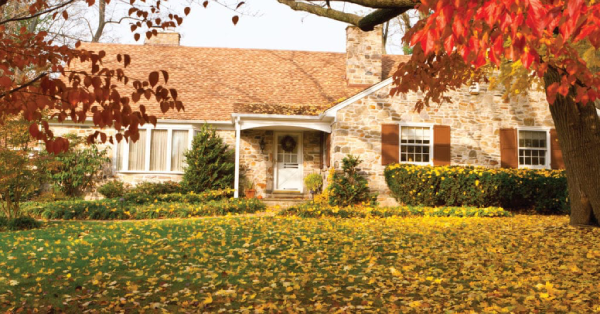When autumn arrives, trees defend the cold by sticking to their core. They embrace the season changing by getting rid of their leaves to reveal bare trunks and branches. These cooler temperatures damage leaves and cause them to drop by the thousands across your yard. For some homeowners, when the fall arrives, trees become your worst enemy! None of us like to rake, but with these handy tips from the lawn care pros at Lawn Pride, you can turn this season’s least favorite chore into an effortless, quick, and beneficial yard activity.

Your Leaf Removal Options
This may be the only time of year you wish you had a smaller yard. What’s the best way to remove all those leaves? Check out your options.
- Raking. One of the oldest methods is still one of the most popular … and most back-breaking. Raking gets the job done better than just about everything else, but it takes time and plenty of manual labor. If you care about the environment, this is one of the most eco-friendly ways to maintain your lawn.
- Mulching. A push or riding lawn mower makes quick work of fallen leaves, and the leftover bits act as natural fertilizer for grass. Just make sure you don’t leave piles of mulch behind, but instead scatter it evenly across the yard. And, avoid mowing over big piles of leaves as well, as these can clog up and cause problems with your machine.
- Composting. Just like most produce waste from your kitchen, leaves make great compost material. While whole leaves are sometimes difficult to break down, garden experts recommend adding nitrogen (such as manure) to your compost pile, or shredding the leaves before adding them to the mix.
- “Leaving” them be. Pardon the autumn pun, but this is also a valid option. However, fallen leaves can carry the risk of disease. While these don’t typically spread to grass, dense wet piles weighed down by winter snow can smother your lawn. That’s one thing you won’t want to worry about come springtime next year.
Essential Leaf Removal Equipment
Even if you never plan to do the entire yard, a rake is a must for any homeowner. Rakes with plastic heads are cheaper and lighter than metal rakes, but they are less durable and tend to clog more often. Also, remember this - if you happen to break your rake handle, often times you don’t need a whole new rake. Just remove the handle from the head and replace. Most home improvement stores sell standalone replacement handles. Don’t want to rake or pay the kid down the block to do it for you? Invest in a quality leaf blower. These machines come in corded, gas-powered, and even rechargable battery-powered variants. Look for the blower with the strongest cubic feet per minute, or CFM, rating in your price range. Also, while leaf blowers are powerful, they are noisy, so invest in some decent hearing protection while you’re at it. They can be heavy, too, so take that fact into account (along with the added weight of a tank of gas, a battery pack, or 50 feet of extension cord).
Where Do All Those Leaves Go?
Be sure to place your leaf litter in the proper spot once you are done. Depending on your local ordinances, leaves should be raked to a specific area on the edge of your property, along the curb, or placed in a yard waste receptacle. If you have storm drains on your road, keep leaves out of the street. Likewise, while folks can burn them out in the country, you shouldn’t do this if you live within city limits. Contact your local solid waste department or similar municipal agency for guidance on what to do. Like these tips for eliminating leaves in your yard? Check out other fall preparation tips to keep your lawn healthy and strong throughout the winter season. Contact us today for other fall services such as fall fertilization, tree and shrub services, or aeration and overseeding. Your friends at Lawn Pride wish you a wonderful fall season!
